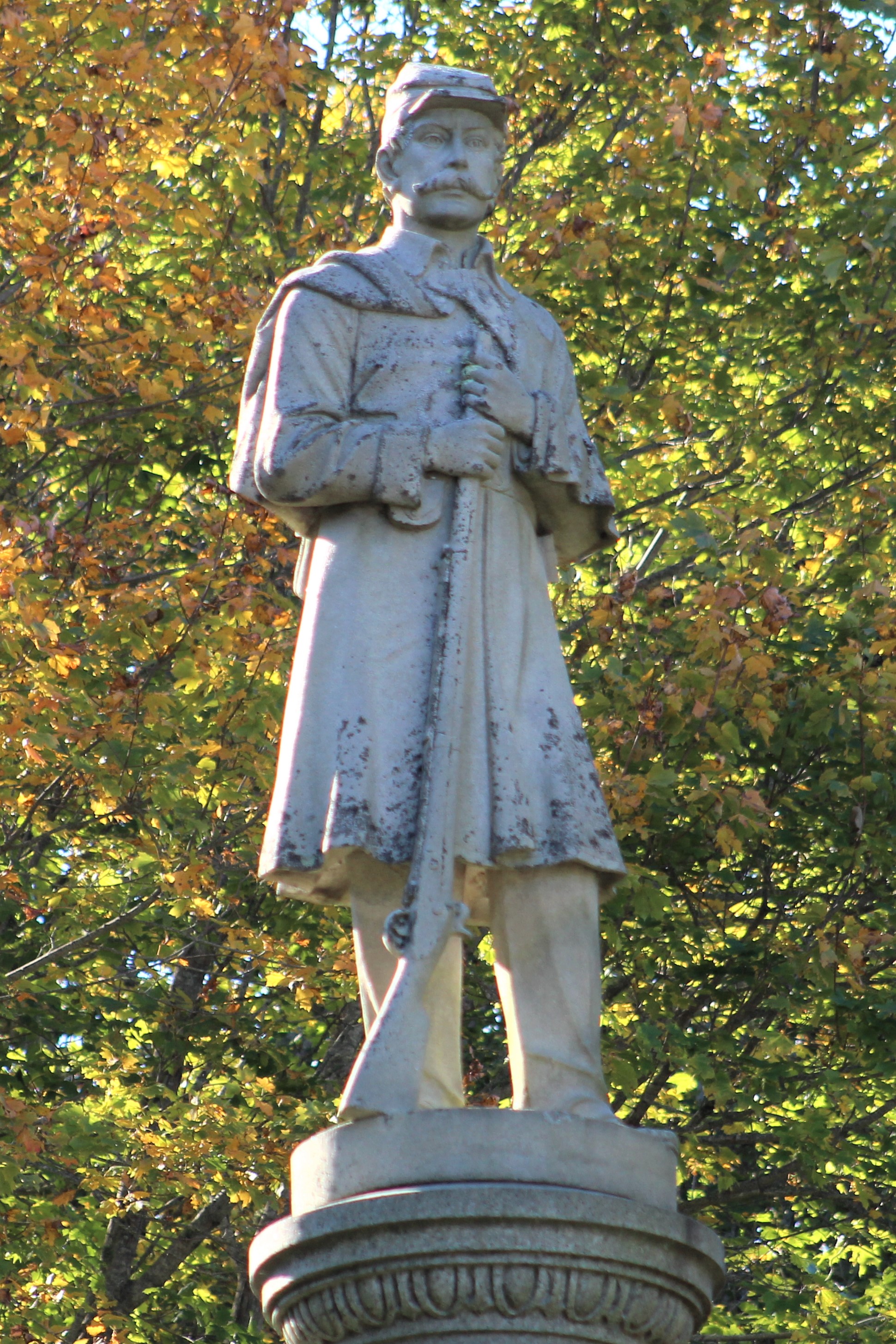
 Location: Eaton Square, 1 Grove Street, Sandwich
Location: Eaton Square, 1 Grove Street, Sandwich
Coordinates: 41°45’30.2″N 70°30’03.4″W
Date dedicated: May 30, 1911
Architect/sculptor/manufacturer: Joss Brothers, Quincy, manufacturer
The Sandwich Civil War monument was gifted to the town by William Eaton and constructed on a plot of ground next to the town hall which, after the dedication, came to be known as Eaton Square. Eaton grew up in Sandwich before the Civil War. His father, an immigrant who worked at the Boston and Sandwich Glass Works, died when Eaton was eight years old. This required Eaton to take up work at the Glass Works at a young age and he struggled to support his mother and siblings. Eventually, the chief engineer took Eaton under his wing and trained him in the maintenance of steam engines.[1]
 Eaton moved away from Sandwich and went on to have a prosperous career as a steam engineer but he long remembered the many young workers from the factory, his friends, who went off to serve during the Civil War. Eaton was too young to serve as a soldier himself. He dedicated the monument to his father’s memory and to those “defenders of the Union” who died in the war. For more information on Eaton, see the article by William F. Daley written for the Sandwich Historical Commission here. According to Daley, without Eaton the monument likely would never have been built as the town took up the matter in 1867 but voted to postpone a monument indefinitely.
Eaton moved away from Sandwich and went on to have a prosperous career as a steam engineer but he long remembered the many young workers from the factory, his friends, who went off to serve during the Civil War. Eaton was too young to serve as a soldier himself. He dedicated the monument to his father’s memory and to those “defenders of the Union” who died in the war. For more information on Eaton, see the article by William F. Daley written for the Sandwich Historical Commission here. According to Daley, without Eaton the monument likely would never have been built as the town took up the matter in 1867 but voted to postpone a monument indefinitely.
The dedication of the monument took place on Memorial Day, 1911. During the ceremonies, John F. Fitzgerald (“Honey Fitz”), Mayor of Boston and grandfather of President John F. Kennedy, gave an address. He urged, “Let us give no heed to the croaking pessimist who would tell us that the great principles for which these soldiers fought and died are less loved by our people now than then.”[2] In those segments of his address printed in the Boston Globe, he did not elaborate on precisely what principles he was referring to.
The first company of volunteers who departed Sandwich (indeed, the first group organized on the Cape in response to the call to arms) was known as the “Sandwich Guards” and consisted of 56 men from Sandwich and eight men from other towns.[3] They were led by Capt. Charles Chipman, a machinist from Sandwich who had served as a sergeant in the Regular Army before the war. They left for Boston on May 8, 1861 with the understanding that they would serve a three month term as Company D of the 3rd Massachusetts Militia. Once they reached Boston, however, they were informed that they would have to serve a term of three years. The company returned to Sandwich on May 9 to consider the matter and to make the necessary preparations for a much longer term of service. When the company reached home, they marched to the town hall where Capt. Chipman called the roll and the entire company, except one man, agreed to serve for three years.[4]
The Sandwich Guards served as part of the 3rd Massachusetts for three months and then became Company D of the 29th Massachusetts Infantry for the remainder of their term. Promoted to Major, Chipman led the 29th Massachusetts during several engagements in 1864 as they were without a colonel. During the Siege of Petersburg, on August 7, 1864, Major Chipman was killed in the midst of a particularly heavy artillery bombardment along the the trench lines. The regimental historian described Chipman and his leadership in the highest terms. After the war, friends commissioned an oil portrait of Chipman to hang in a Boston gallery of “departed heroes.” When the portrait fell into private hands, veterans of the 29th Massachusetts raised a fund to buy it back and presented it to his widow. The portrait is now in the collection of the Sandwich Glass Museum.
[1] William F. Daley, “William Eaton and the Soldiers’ and Sailors’ Monument,” Sandwich Historical Commission
[2] The Boston Globe, May 31, 1911, 10.
[3] George Nason, History and Complete Roster of the Massachusetts Regiments, Minute Men of ’61, (Boston: Smith and McCance, 1910), 20-21.
[4] William H. Osborne, The History of the Twenty-ninth Regiment of Massachusetts Volunteer Infantry, (Boston: A. J. Wright, printer, 1877), 20.